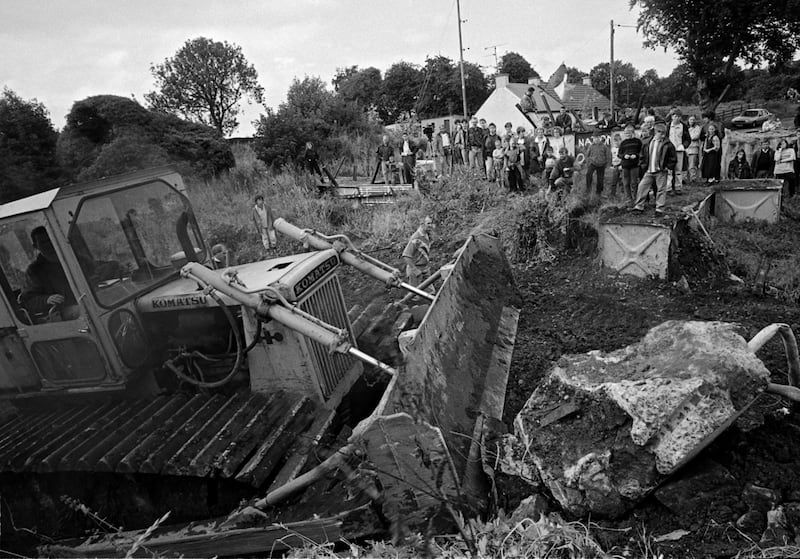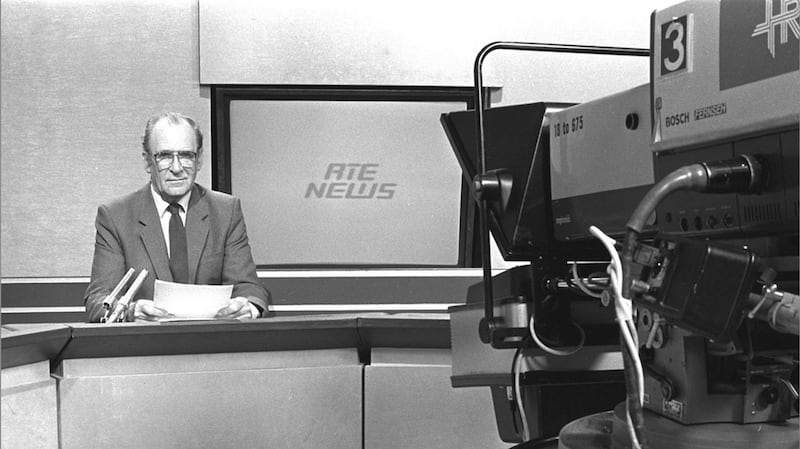In the analogue era, receiving RTÉ in most parts of Northern Ireland required an extra aerial. A symbol of reaching out for a signal from somewhere else. And as well as picking up a signal, it transmitted one – its owners' desire to be connected to the rest of the island in a way that would not have occurred to the some of their neighbours. Or that might be overthinking it: it may just have been a way of watching Buffy and Friends a few weeks ahead of British channels, for free.
In the Republic, watching British terrestrial TV usually, though not always, has also meant watching Northern Irish TV, but more often than not the Northern component was incidental. There is scant evidence of anyone in the 26 counties deliberately seeking out UTV for the fishwife patter of continuity announcer Julian Simmons, or BBC Northern Ireland's beloved "Uncle" Hugo Duncan. Both of them are unarguably household names in the North but would likely walk unnoticed down Grafton Street.
The Border has re-entered political discourse, but what about the border in cultural experience? Not traditional forms of cultural expression, which have political meanings of their own, or the higher written culture with which this island has defined itself more than most, but the mass culture of TV and popular music.

By coincidence, Ireland was partitioned at the same time as new forms of mass media emerged which were to shape the rest of the 20th century. In February 1921, three months before Ireland was formally divided into two jurisdictions, Charlie Chaplin's first feature-length film, The Kid, was released. In July of that year, HMV opened its first gramophone shop in London. Still, we talk little of how the mass of culture we consume affects the way we view each other.
RTÉ channels were not always on, but sought out for specific programming; the most prized of which was inevitably the Late Late Toy Show
For part of my childhood, watching RTÉ required physically reaching into cables behind the TV and flicking an alternator switch on a small box. This small inconvenience meant that RTÉ channels were not always on, but sought out for specific programming; the most prized of which was inevitably the Late Late Toy Show, so beloved that it was taped for rewatching or sharing with those who did not receive RTÉ.
Since there were endless programmes on British TV saturated with toy prizes, what was the unique appeal of the toy show? It had something to do with its Irishness and the sense that if the State broadcaster in the still heavily confessional Republic could encourage such wanton materialism in children, then how much harm could it be for the little Catholic children of the North?
But as intrinsic a part of Christmas as the toy show was for me, others nearby were oblivious. "I wouldn't have known anything about the toy show, other than some friends who got RTÉ mentioned it," says Ruth Sanderson, a broadcaster from Banbridge in Co Down who now appears regularly on BBC Northern Ireland. Her family couldn't get RTÉ because they lived "in a dip".
Though her family were enthusiastically cross-community inside Northern Ireland (her father was a Presbyterian minister) geography meant her media intake was decidedly non cross-Border. "I remember hearing about Gerry Ryan dying and not knowing who he was, which is bizarre because he was a household name a few miles down the road. But in our house we were listening to Radio Ulster and Radio 4."

In Northern Ireland, cultural choices are loaded with meaning, even when we don't mean them to be. Eamonn Mallie, one of the North's most famous journalists and broadcasters, grew up near the Border in South Armagh and recalls the story of a local farmer in the 1960s who owned a television before his neighbours. Naturally oriented – like many in that part of the world – to the South rather than the North. This farmer got his nightly news from the newly minted Raidió Teilifís Éireann. "Every night, he and his wife dressed up to watch [legendary newsreader] Charles Mitchel read the news," says Mallie. "And at the end of the broadcast when Charles Mitchel said 'good night', Paddy would say 'good night' back to him."
Such innocence was not limited to the 1960s. My friend Sarah Mills from Rostrevor, whose family lived on the shore of Carlingford Lough with the Mournes behind them, could only receive RTÉ channels, despite living in Northern Ireland. She remembers as a child feeling confused when puppet aliens Zig and Zag abruptly disappeared from The Den, unaware they were now on the Big Breakfast every morning, a Channel 4 programme they could not receive.
Cultural distinctiveness – a desire to demarcate cultural separateness – was of course part of the reason Raidió TeilifísÉireann was established. But it could only mitigate, rather than remove entirely, the effect of British TV broadcast from the North. And it was definitively British programming that viewers tended to be seeking out – and not the small portions of Northern Ireland-specific content shown on BBC NI and Ulster Television.
Encounters with indigenous Northern programming often seems to have baffled or simply bored Southern viewers. Gráinne Keenan, an actor from Dublin with family in the North, has played lots of Northern characters thanks to a facility with the accent afforded from having a mother from Belfast. "There is still a kind of ignorance about the North in the Republic," she says. "Britain was a much bigger influence than Northern Ireland. I was obsessed with British soaps growing up and watched a lot of British TV – but anything specifically about the North was just what came between those shows in news bulletins."
If the weather bulletin was on, you'd watch it because the weather in the west of Northern Ireland would pretty much be your weather too
Further west and further North – closer to the Border – things were slightly different. "We definitely watched Northern TV," says Peter Geoghegan, a Glasgow-based journalist originally from Longford. "I dare say more than they would have done in Dublin." Other more prosaic factors came into play: "If the weather bulletin was on, you'd watch it because the weather in the west of Northern Ireland would pretty much be your weather too." Geoghegan specifically references the late Gerry Anderson, whose surreal morning show on Radio Ulster subverted the leaden bigotry often broadcast on Northern airwaves.
Of course, getting even incidental nordie culture was, and is dependent on, where your signal is coming from. Significant parts of the South and east of Ireland have always received their spillover BBC from Welsh, not Northern, transmitters. Muireann Kelliher now works in business but also as an adviser to Other Voices, the Dingle-based music festival. Moving between Longford, Dublin and Kerry as a child they variously watched Northern Irish and Welsh versions of UK TV, and in Kerry, no British TV at all. The impression of the North that was left was slight. "I actually had no exposure, high up or low down, to Northern culture growing up. It was like a curtain was in place but nothing iron about it."
But if there is a strand of popular culture indifferent to the Border, it is live music. Earlier in his career, Anderson was a showband musician when that was the defining live music medium on the island. Much has been written about the all-Ireland nature of the showband scene, and the uniqueness of the showband aesthetic in general. Where in Britain or America musical genres seemed naturally to split off and redefine themselves, showbands were defined by fusing genres – that and relentless performance all over the island. The bands themselves, and the crowds which watched them, were cross-Border.
Mallie points out that in earlier, less-security minded times, young Protestant residents of places as far north as Portadown would cross the Border to Carrickmacross and Castleblayney to watch showbands. Particularly on Sundays – when the heavily sabbatarian parts of the North forbade dances. My mother confesses to having had little interest in Irish showbands and much more passion for the English bands who were at that stage invading America. But, growing up in Derry, she did go to the iconically named Borderland in Muff, adjacent to the literal border – oddly now an outdoor goods store, though with the interior and exterior remarkably unchanged.
Travelling South is redolent not so much of political identity, but something even more fundamental: youth
Even with the security concerns of the past gone, the sheer smallness of Northern Ireland means that going to a big gig, or a festival, has usually meant crossing the Border to Slane, Oxegen or a stadium in Dublin. Coaches and parents' borrowed cars, laden with camping equipment and beer, heading South in search of the shared joy of live music and a crowd. In the case of my friends, so habitual was the cross-Border journey for music that we became perhaps too omnivorous – as an old ticket stub for a Bryan Adams concert at Slane wanly testifies. For many of us, travelling South is redolent not so much of political identity, but something even more fundamental: youth.
Angela Hunter, originally from a unionist part of east Belfast but now living in London, remembers travelling to a Bon Jovi gig at the RDS one July in the mid-1990s – memorable for the music and an argument with a teenage boyfriend torn between the concert and an Orange march he was due to be on.
Journeys in the other direction have been less common. Peter Geoghegan recalls a trip to Belfast’s Empire Music Hall to watch Godspeed You Black Emperor, the cult Canadian band, and also the quality of Belfast’s independent record shops. But generally it is safe to assume that when most people in the Republic think of the North, it has been rarely been culture – either popular or avant garde – that comes to mind.
In 2012, a Samuel Beckett-themed festival, Happy Days, was established in Fermanagh, followed later by associated festivals focussed on Oscar Wilde and Brian Friel. One of its founders, Derry-born Seán Doran – a veteran of arts festivals worldwide – says that when he returned to work in Northern Ireland after years abroad, the cultural otherness of the place had not reduced but intensified. "The separation, viewed from South to North, is I think absolutely vast and psychically so, so deep." Part of what inspires the festivals – collectively branded Arts Over Borders – is the attempt to make people in the Republic think differently about the culture and creativity that spans the Border. "I would hope at least some people in Dublin will have had to look up to Fermanagh and say, 'what on earth is Beckett doing up there?' "
Beckett is far from mass culture. But Doran is not the only person who thinks the political impasse surrounding the Border is prompting people on the southern side of it to pay attention to the cultural possibilities of the North. As is the success of Derry Girls – a comedy rooted in the North and honest about the Troubles without being just about the Troubles – as well as Northern Ireland’s emergence as a major filming location.
Northern Ireland once acted as an unwitting – and unacknowledged – bridgehead for modernity in the Republic. Decades later, is it too much to hope for some modernity to be transmitted back in the opposite direction?






















